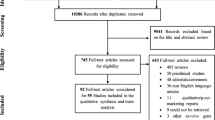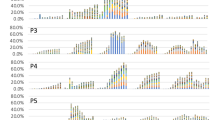Abstract
In clinical gene therapy trials for X-linked severe combined immunodeficiency, the development of leukemia has come up as a severe adverse effect. In all five cases, T-cell acute lymphoblastic leukemia (T-ALL) occurred as a direct consequence of insertional mutagenesis by the retrovirus used to deliver the therapeutic gene. Here, we review the mechanisms of insertional mutagenesis, the fuction of the Il2RG gene and the future developments in the field. New lentiviral and γ retroviral vectors can significantly improve the safety profile of the tools used but still carry the risk of insertional mutagenesis, as shown in this issue of Leukemia. Finally, the unfortunate side effects of gene therapy have given more insight into the development of human T-ALL.
This is a preview of subscription content, access via your institution
Access options
Subscribe to this journal
Receive 12 print issues and online access
$259.00 per year
only $21.58 per issue
Buy this article
- Purchase on Springer Link
- Instant access to full article PDF
Prices may be subject to local taxes which are calculated during checkout

Similar content being viewed by others
References
Hacein-Bey-Abina S, von Kalle C, Schmidt M, Le Deist F, Wulffraat N, McIntyre E et al. A serious adverse event after successful gene therapy for X-linked severe combined immunodeficiency. N Engl J Med 2003; 348: 255–256.
Hacein-Bey-Abina S, Von Kalle C, Schmidt M, McCormack MP, Wulffraat N, Leboulch P et al. LMO2-associated clonal T cell proliferation in two patients after gene therapy for SCID-X1. Science 2003; 302: 415–419.
Howe S, Mansour M, Schwarzwaelder K, Bartholomae C, Hubank M, Kempski H et al. Insertional mutagenesis in combination with acquired somatic mutations leads to leukemogenesis following gene therapy of SCID-X1. J Clin Invest 2008, doi:10.1172/JCI35798.
Hacein-Bey-Abina S, Garrigue A, Wang GP, Soulier J, Lim A, Morillon E et al. Insertional oncogenesis in 4 patients after retrovirus-mediated gene therapy of SCID-X1. J Clin Invest, doi:10.1172/JCI35700.
Baum C, von Kalle C, Staal FJ, Li Z, Fehse B, Schmidt M et al. Chance or necessity? Insertional mutagenesis in gene therapy and its consequences. Mol Ther 2004; 9: 5–13.
Cavazzana-Calvo M, Fischer A . Gene therapy for severe combined immunodeficiency: are we there yet? J Clin Invest 2007; 117: 1456–1465.
Gaspar HB, Thrasher AJ . Gene therapy for severe combined immunodeficiencies. Expert Opin Biol Ther 2005; 5: 1175–1182.
Pike-Overzet K, van der Burg M, Wagemaker G, van Dongen JJ, Staal FJ . New insights and unresolved issues regarding insertional mutagenesis in X-linked SCID gene therapy. Mol Ther 2007; 15: 1910–1916.
Baum C, Dullmann J, Li Z, Fehse B, Meyer J, Williams DA et al. Side effects of retroviral gene transfer into hematopoietic stem cells. Blood 2003; 101: 2099–2114.
Modlich U, Schambach A, Brugman MH, Wicke DC, Knoess S, Li Z et al. Leukemia induction after a single retroviral vector insertion in Evi1 or Prdm16. Leukemia 2008; 22: 1519–1528.
Baum C . Insertional mutagenesis in gene therapy and stem cell biology. Curr Opin Hematol 2007; 14: 337–342.
Pike-Overzet K, de Ridder D, Weerkamp F, Baert MR, Verstegen MM, Brugman MH et al. Ectopic retroviral expression of LMO2, but not IL2Rgamma, blocks human T-cell development from CD34+ cells: implications for leukemogenesis in gene therapy. Leukemia 2007; 21: 754–763.
Dave UP, Jenkins NA, Copeland NG . Gene therapy insertional mutagenesis insights. Science 2004; 303: 333.
Woods NB, Bottero V, Schmidt M, von Kalle C, Verma IM . Gene therapy: therapeutic gene causing lymphoma. Nature 2006; 440: 1123.
Pike-Overzet K, de Ridder D, Weerkamp F, Baert MR, Verstegen MM, Brugman MH et al. Gene therapy: is IL2RG oncogenic in T-cell development? Nature 2006; 443: E5; discussion E6–7.
Thrasher AJ, Gaspar HB, Baum C, Modlich U, Schambach A, Candotti F et al. Gene therapy: X-SCID transgene leukaemogenicity. Nature 2006; 443: E5–E6; discussion E6–7.
Shou Y, Ma Z, Lu T, Sorrentino BP . Unique risk factors for insertional mutagenesis in a mouse model of XSCID gene therapy. Proc Natl Acad Sci USA 2006; 103: 11730–11735.
Montini E, Cesana D, Schmidt M, Sanvito F, Ponzoni M, Bartholomae C et al. Hematopoietic stem cell gene transfer in a tumor-prone mouse model uncovers low genotoxicity of lentiviral vector integration. Nat Biotechnol 2006; 24: 687–696.
Modlich U, Bohne J, Schmidt M, von Kalle C, Knoss S, Schambach A et al. Cell-culture assays reveal the importance of retroviral vector design for insertional genotoxicity. Blood 2006; 108: 2545–2553.
Kustikova O, Fehse B, Modlich U, Yang M, Dullmann J, Kamino K et al. Clonal dominance of hematopoietic stem cells triggered by retroviral gene marking. Science 2005; 308: 1171–1174.
Li Z, Dullmann J, Schiedlmeier B, Schmidt M, von Kalle C, Meyer J et al. Murine leukemia induced by retroviral gene marking. Science 2002; 296: 497.
Thornhill SI, Schambach A, Howe SJ, Ulaganathan M, Grassman E, Williams D et al. Self-inactivating gammaretroviral vectors for gene therapy of X-linked severe combined immunodeficiency. Mol Ther 2008; 16: 590–598.
Wu X, Li Y, Crise B, Burgess SM . Transcription start regions in the human genome are favored targets for MLV integration. Science 2003; 300: 1749–1751.
Trono D . Virology. Picking the right spot. Science 2003; 300: 1670–1671.
De Palma M, Montini E, de Sio FR, Benedicenti F, Gentile A, Medico E et al. Promoter trapping reveals significant differences in integration site selection between MLV and HIV vectors in primary hematopoietic cells. Blood 2005; 105: 2307–2315.
Mitchell RS, Beitzel BF, Schroder AR, Shinn P, Chen H, Berry CC et al. Retroviral DNA integration: ASLV, HIV, and MLV show distinct target site preferences. PLoS Biol 2004; 2: E234.
Lewinski MK, Yamashita M, Emerman M, Ciuffi A, Marshall H, Crawford G et al. Retroviral DNA integration: viral and cellular determinants of target-site selection. PLoS Pathog 2006; 2: e60.
Deichmann A, Hacein-Bey-Abina S, Schmidt M, Garrigue A, Brugman MH, Hu J et al. Vector integration is nonrandom and clustered and influences the fate of lymphopoiesis in SCID-X1 gene therapy. J Clin Invest 2007; 117: 2225–2232.
Schwarzwaelder K, Howe SJ, Schmidt M, Brugman MH, Deichmann A, Glimm H et al. Gammaretrovirus-mediated correction of SCID-X1 is associated with skewed vector integration site distribution in vivo. J Clin Invest 2007; 117: 2241–2249.
Aiuti A, Cassani B, Andolfi G, Mirolo M, Biasco L, Recchia A et al. Multilineage hematopoietic reconstitution without clonal selection in ADA-SCID patients treated with stem cell gene therapy. J Clin Invest 2007; 117: 2233–2240.
Schmidt M, Carbonaro DA, Speckmann C, Wissler M, Bohnsack J, Elder M et al. Clonality analysis after retroviral-mediated gene transfer to CD34+ cells from the cord blood of ADA-deficient SCID neonates. Nat Med 2003; 9: 463–468.
Schmidt M, Schwarzwaelder K, Bartholomae C, Zaoui K, Ball C, Pilz I et al. High-resolution insertion-site analysis by linear amplification-mediated PCR (LAM-PCR). Nat Methods 2007; 4: 1051–1057.
Ng YY, van Kessel B, Lokhorst HM, Baert MR, van den Burg CM, Bloem AC et al. Gene-expression profiling of CD34+ cells from various hematopoietic stem-cell sources reveals functional differences in stem-cell activity. J Leukoc Biol 2004; 75: 314–323.
Zhong JF, Zhao Y, Sutton S, Su A, Zhan Y, Zhu L et al. Gene expression profile of murine long-term reconstituting vs short-term reconstituting hematopoietic stem cells. Proc Natl Acad Sci USA 2005; 102: 2448–2453.
Dik WA, Pike-Overzet K, Weerkamp F, de Ridder D, de Haas EF, Baert MR et al. New insights on human T cell development by quantitative T cell receptor gene rearrangement studies and gene expression profiling. J Exp Med 2005; 201: 1715–1723.
Fehse B, Kustikova OS, Bubenheim M, Baum C . Pois(s)on—it's a question of dose. Gene Ther 2004; 11: 879–881.
Kustikova OS, Wahlers A, Kuhlcke K, Stahle B, Zander AR, Baum C et al. Dose finding with retroviral vectors: correlation of retroviral vector copy numbers in single cells with gene transfer efficiency in a cell population. Blood 2003; 102: 3934–3937.
Modlich U, Kustikova OS, Schmidt M, Rudolph C, Meyer J, Li Z et al. Leukemias following retroviral transfer of multidrug resistance 1 (MDR1) are driven by combinatorial insertional mutagenesis. Blood 2005; 105: 4235–4246.
Ito M, Kobayashi K, Nakahata T . NOD/Shi-scid IL2rgamma(null) (NOG) mice more appropriate for humanized mouse models. Curr Top Microbiol Immunol 2008; 324: 53–76.
Pearson T, Greiner DL, Shultz LD . Humanized SCID mouse models for biomedical research. Curr Top Microbiol Immunol 2008; 324: 25–51.
Author information
Authors and Affiliations
Corresponding author
Rights and permissions
About this article
Cite this article
Staal, F., Pike-Overzet, K., Ng, Y. et al. Sola dosis facit venenum. Leukemia in gene therapy trials: a question of vectors, inserts and dosage?. Leukemia 22, 1849–1852 (2008). https://doi.org/10.1038/leu.2008.219
Received:
Revised:
Accepted:
Published:
Issue Date:
DOI: https://doi.org/10.1038/leu.2008.219
Keywords
This article is cited by
-
In utero stem cell transplantation and gene therapy: rationale, history, and recent advances toward clinical application
Molecular Therapy - Methods & Clinical Development (2016)
-
Mature T-cell Lymphomagenesis Induced by Retroviral Insertional Activation of Janus Kinase 1
Molecular Therapy (2013)
-
Induced pluripotent stem cells and severe combined immunodeficiency: merely disease modeling or potentially a novel cure?
Pediatric Research (2012)
-
Stem cell self-renewal: lessons from bone marrow, gut and iPS toward clinical applications
Leukemia (2011)
-
Correction of murine Rag1 deficiency by self-inactivating lentiviral vector-mediated gene transfer
Leukemia (2011)



